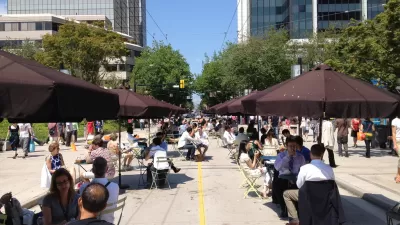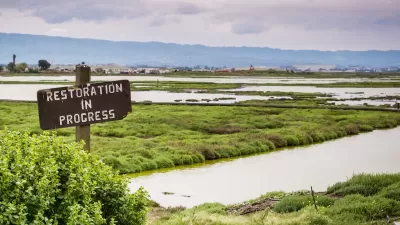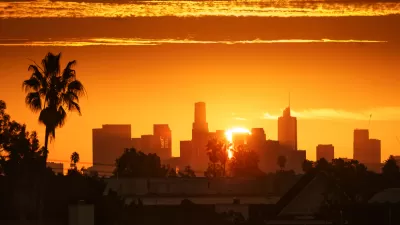The city of Vancouver's new Climate Emergency Action Plan incorporates a comprehensive scope of goals, including affordability, public health, and social equity, which can help build broad public support.

The city of Vancouver's new 371-page Climate Emergency Action Plan includes ambitious targets (called "Big Moves") to reduce climate change emissions and achieve other economic, social and environmental goals.
Big Move 1: by 2030, 90% of people live within an easy walk/roll of their daily needs. Make low-cost sustainable transportation options easy, safe and reliable for all Vancouverites, so that people get to work, school and other destinations without needing to rely on gas and diesel vehicles and the noise and pollution they produce.
Big Move 2: By 2030, two thirds of all trips in Vancouver will be made on foot, bike or transit.
Big Move 3: By 2030, 50% of the kilometres driven on Vancouver’s roads will be by zero emissions vehicles.
Big Move 4: By 2030, the carbon pollution from buildings will be cut in half from 2007 levels.
Big Move 5: By 2030, the embodied emissions from new buildings will be reduced by 40% compared to a 2018 baseline.
Additional goals:
Ensure that everyone has the opportunity to live and work in zero emissions buildings, and is able to benefit from the comfort, quiet, healthy air, and lower energy costs they offer.
Share the costs of reducing our carbon pollution in ways that reflect people’s ability to contribute to that transition.
Create new and varied opportunities for people to participate in a zero-carbon economy, including the support people need to transition to those opportunities.
According to modeling, the plan can achieve the city's emission reduction goals and provide significant co-benefits. It will require an estimated $1.27 billion worth of investments in solutions, such as electric vehicles and heat pumps, which will generate $2.25 billion savings and provide non-financial benefits including regional economic development, improved health from reduced noise and pollution, and more active lifestyles, plus municipal cost savings from reduced storm flooding, extreme heat, and wildfire smoke.


For news coverage of Vancouver's new Climate Emergency Action Plan, see an article by Mike Howell.
FULL STORY: Vancouver Climate Emergency Action Plan

Alabama: Trump Terminates Settlements for Black Communities Harmed By Raw Sewage
Trump deemed the landmark civil rights agreement “illegal DEI and environmental justice policy.”

Planetizen Federal Action Tracker
A weekly monitor of how Trump’s orders and actions are impacting planners and planning in America.

Why Should We Subsidize Public Transportation?
Many public transit agencies face financial stress due to rising costs, declining fare revenue, and declining subsidies. Transit advocates must provide a strong business case for increasing public transit funding.

Understanding Road Diets
An explainer from Momentum highlights the advantages of reducing vehicle lanes in favor of more bike, transit, and pedestrian infrastructure.

New California Law Regulates Warehouse Pollution
A new law tightens building and emissions regulations for large distribution warehouses to mitigate air pollution and traffic in surrounding communities.

Phoenix Announces Opening Date for Light Rail Extension
The South Central extension will connect South Phoenix to downtown and other major hubs starting on June 7.
Urban Design for Planners 1: Software Tools
This six-course series explores essential urban design concepts using open source software and equips planners with the tools they need to participate fully in the urban design process.
Planning for Universal Design
Learn the tools for implementing Universal Design in planning regulations.
Caltrans
Smith Gee Studio
Institute for Housing and Urban Development Studies (IHS)
City of Grandview
Harvard GSD Executive Education
Toledo-Lucas County Plan Commissions
Salt Lake City
NYU Wagner Graduate School of Public Service





























